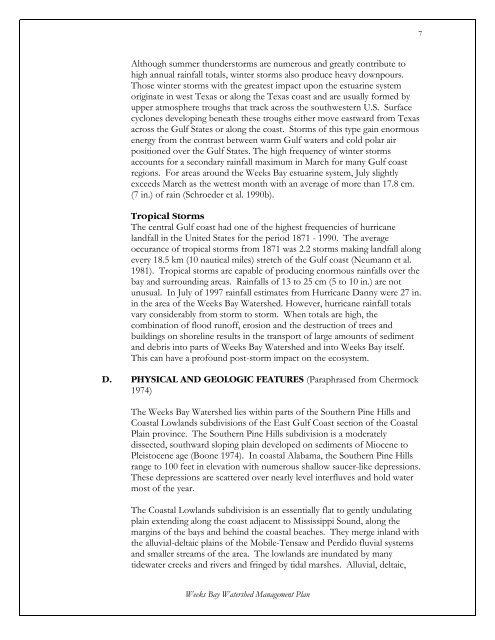Weeks Bay Watershed Project Management Plan - Mobile Bay ...
Weeks Bay Watershed Project Management Plan - Mobile Bay ...
Weeks Bay Watershed Project Management Plan - Mobile Bay ...
Create successful ePaper yourself
Turn your PDF publications into a flip-book with our unique Google optimized e-Paper software.
7<br />
Although summer thunderstorms are numerous and greatly contribute to<br />
high annual rainfall totals, winter storms also produce heavy downpours.<br />
Those winter storms with the greatest impact upon the estuarine system<br />
originate in west Texas or along the Texas coast and are usually formed by<br />
upper atmosphere troughs that track across the southwestern U.S. Surface<br />
cyclones developing beneath these troughs either move eastward from Texas<br />
across the Gulf States or along the coast. Storms of this type gain enormous<br />
energy from the contrast between warm Gulf waters and cold polar air<br />
positioned over the Gulf States. The high frequency of winter storms<br />
accounts for a secondary rainfall maximum in March for many Gulf coast<br />
regions. For areas around the <strong>Weeks</strong> <strong>Bay</strong> estuarine system, July slightly<br />
exceeds March as the wettest month with an average of more than 17.8 cm.<br />
(7 in.) of rain (Schroeder et al. 1990b).<br />
Tropical Storms<br />
The central Gulf coast had one of the highest frequencies of hurricane<br />
landfall in the United States for the period 1871 - 1990. The average<br />
occurance of tropical storms from 1871 was 2.2 storms making landfall along<br />
every 18.5 km (10 nautical miles) stretch of the Gulf coast (Neumann et al.<br />
1981). Tropical storms are capable of producing enormous rainfalls over the<br />
bay and surrounding areas. Rainfalls of 13 to 25 cm (5 to 10 in.) are not<br />
unusual. In July of 1997 rainfall estimates from Hurricane Danny were 27 in.<br />
in the area of the <strong>Weeks</strong> <strong>Bay</strong> <strong>Watershed</strong>. However, hurricane rainfall totals<br />
vary considerably from storm to storm. When totals are high, the<br />
combination of flood runoff, erosion and the destruction of trees and<br />
buildings on shoreline results in the transport of large amounts of sediment<br />
and debris into parts of <strong>Weeks</strong> <strong>Bay</strong> <strong>Watershed</strong> and into <strong>Weeks</strong> <strong>Bay</strong> itself.<br />
This can have a profound post-storm impact on the ecosystem.<br />
D. PHYSICAL AND GEOLOGIC FEATURES (Paraphrased from Chermock<br />
1974)<br />
The <strong>Weeks</strong> <strong>Bay</strong> <strong>Watershed</strong> lies within parts of the Southern Pine Hills and<br />
Coastal Lowlands subdivisions of the East Gulf Coast section of the Coastal<br />
Plain province. The Southern Pine Hills subdivision is a moderately<br />
dissected, southward sloping plain developed on sediments of Miocene to<br />
Pleistocene age (Boone 1974). In coastal Alabama, the Southern Pine Hills<br />
range to 100 feet in elevation with numerous shallow saucer-like depressions.<br />
These depressions are scattered over nearly level interfluves and hold water<br />
most of the year.<br />
The Coastal Lowlands subdivision is an essentially flat to gently undulating<br />
plain extending along the coast adjacent to Mississippi Sound, along the<br />
margins of the bays and behind the coastal beaches. They merge inland with<br />
the alluvial-deltaic plains of the <strong>Mobile</strong>-Tensaw and Perdido fluvial systems<br />
and smaller streams of the area. The lowlands are inundated by many<br />
tidewater creeks and rivers and fringed by tidal marshes. Alluvial, deltaic,<br />
<strong>Weeks</strong> <strong>Bay</strong> <strong>Watershed</strong> <strong>Management</strong> <strong>Plan</strong>
















